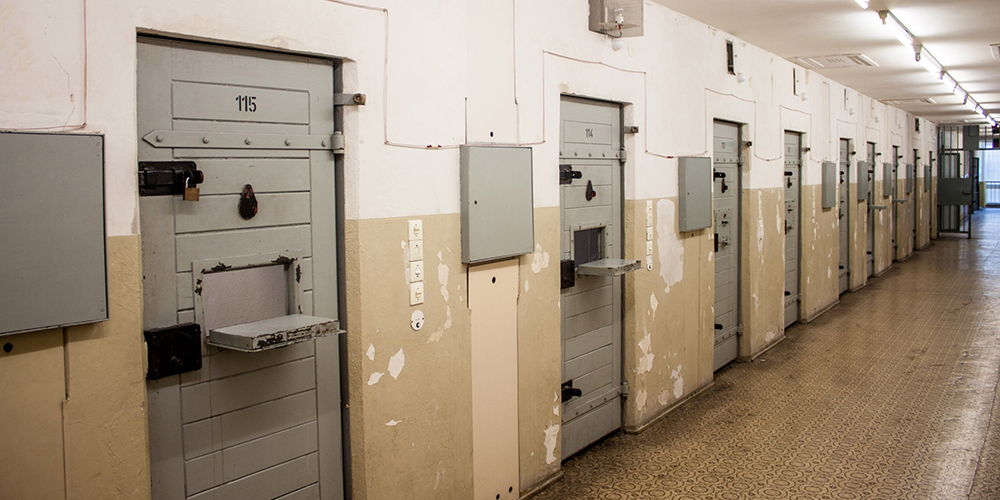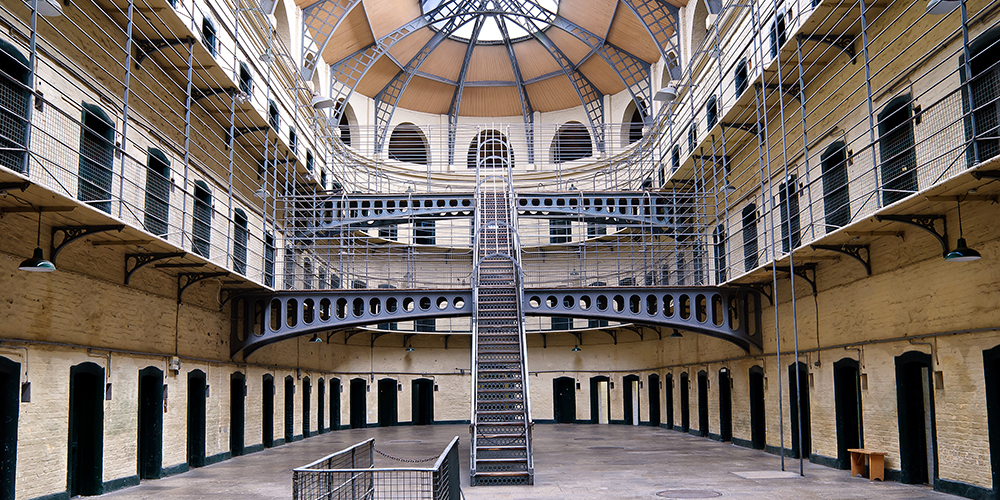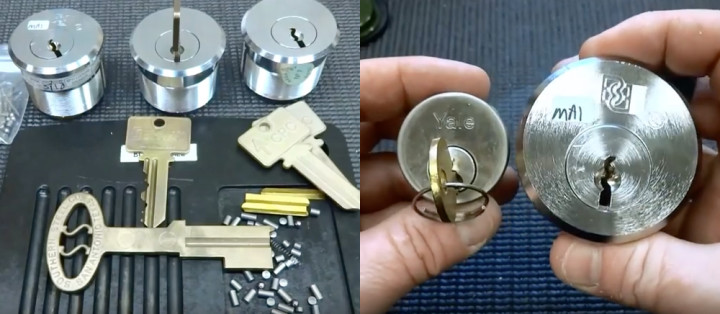Lock Blog
A resource for consumers, locksmiths, and security professionals
A resource for consumers, locksmiths, and security professionals

Today, we take a look at the United States’ most secure institutions. Walking through the history of prisons and the locks that hold them together.
We talk a lot about locks and security on this site, and we often remind readers to always follow their state or local laws when testing their security. But what about the people that break the laws? The latest FBI report on crime states that there are approximately 2 million reported burglaries annually. These criminals that break into locked buildings get caught, and when they get caught, they go to prison. So what kind of locks do United States prisons use? How diverse is the selection? And maybe the most important question of all: how secure are these locks?
There are some very clever measures that have been implemented over the five centuries that penitentiaries have existed, and some blunders. With the privatization of the prison system, and the staggering incarceration rate of 1 in 100 adults, how are they maintaining security? There is no desire to alarm with this article, it is only meant to inform, and should most certainly not be used to assist in any illegal activity.
The history of prisons stretches back more than 500 years, to 16th century England. Before such times as penal incarceration, the method of jailing was much less refined. Dungeons and the like, stretch back much further into human history. In what is now the United States there was surely rudimentary imprisonment even before European colonization, but it was only in the time leading up to the American Revolution (when the United States seceded from Great Britain) that the US began to imprison people as a means of criminal punishment.
It was quickly after the Revolutionary war was over that the role of the private sector in US prisons came into play. Then again, after the end of the American Civil War, convicts were loaned out to plantation owners to fill out their now depleted workforce. It was during the 1980s, however, that we gained the current level of privatization. In the year 1984, the Corrections Corporation of America was founded, and the first fully privatized prison was opened in Hamilton County, TN.
Our prison infrastructure was assembled during three eras in history. Andrew Jackson (known affectionately as the guy on the 20 dollar bill) started a trend of penal labor. This method of rehabilitative labor was most often the penalty for any crime as it guaranteed workers at almost no cost to the state. This period lasted from 1828 to the start of the American Civil War (1861), which extends past the Jacksonian Era.
After the Civil War, the next era begins to gain momentum during the 1890s. In the United States, this marks the beginning of the Progressive Era which introduces certain legal processes into the court system. What comes out of this time period is the practice of parole, probation, and indeterminate sentencing (the chance of life in prison). Though the progressive era would end, historically, with the conclusion of the 1920s, the next big change for the United States prison system would not come about until the 1970’s.
After this 50 year hiatus in change, the prison system saw an explosive expansion. The prison population increased to five times what it was (Gottschalk, 1-2) during this time. Then, between the year 1980 and 2008, the number of Americans quadrupled from about 500,000 to 2.3 million adults. Currently, 1 out of 100 adults are in prison. With the number of people in prison currently combined with the number of adults under probation and supervision, the number rises to 1 in 31. So throughout this history what has kept all these people locked up?

Up until the 1880s, there was not true uniformity to the manufacturing and production of prison locks. It took Folger Adam redirecting his father’s steel company to the manufacturing of detention cells to light the fire under the industry. It would be 17 years later that David F. Youngblood would start his rival company, Southern Steel, and begin manufacturing mechanical sliding doors for prisons. Southern Steel Company formed on the back of the second era of prison expansion, at the beginning of the Progressive Era.
During the second era in 1905 Folger Adam began to produce locks for prison doors. During the span of 1940-1960 Folger Adam made a bid for complete domination and began to acquire the prison lock manufacturing branches of Yale, and Sargent & Greenleaf. By 1967, (with the largest boom in prison population fast approaching) Folger Adam had a monopoly on prison locks for swinging doors, in the strictest sense of the word. The same year as Folger Adam becomes the only manufacturer of prison locks, Southern Steel copied Folger’s designs and went into production.
This duopoly continued until 1978 when RR Brink entered the ring with its locks for swinging prison doors (not yet moving into the sliding door lock market). In the year of 1984 (the beginning of severe prison privatization), the great-grandson of Southern Steel’s founder created Adtec Detention Systems. Adtec then moved forward by getting the Federal Bureau of Prisons to approve their locks, which were just copies of Southern Steel’s designs. In 1989, a company named Airteq Systems created a pneumatic key using the mechanical lock designs of Folger Adam.
A year later Brink began to copy the designs of the newly established Adtec. Then in 2001 Corrections Products Company (CPC) purchased large parts of Adtec. CPC then began to manufacture the designs of all the large competitors and stake their place in the market by offering lower prices. In 2004, Folger Adam and Southern Steel merged into a single company named Southern Folger Detention Equipment Company. We are currently living in this competitive landscape, and will most likely until we reach the fourth era of the US prison system.
Very few movies and television shows will show you the actual inside of a prison. The classic jail bars on a sliding track are more the exception than they are the rule. Most cell doors swing open and outward. The doors will have a small window, but other than that they have a sturdy metal construction with an average weight of 300 pounds, and a standard thickness of 3 inches. You are not going to be able to get out of most cells with a file that someone hid in a birthday cake. And with such sturdy doors, you need powerful and reliable locks.
Electromechanical locks are the most commonly found security device on prison cells. They are designed with a mortise lock and cylinder, which means that the locking mechanism is fitted inside the door. The door is drilled or cut to make a pocket for the mortise lock, and the apparatus is then placed in the hole, opposed to the bored cylindrical locks found in most residential homes. The mortise lock will hold the bolt work of the lock, which are the internal mechanisms that retract and extend the bolts. A mortise cylinder is a device that will allow the key to manipulate the bolt work. For prison locks, these cylinders are often very large, with oversized keyways.
Similarly, the keys are quite large when compared to standard keys for average pin tumbler locks. The thought behind this is that the amount of torque required to open the locks is greater. Also, it is more difficult for a prisoner to gather enough material to make a key that size. A mortise cylinder is also most often threaded so that it can be screwed into the lock, and they are commonly fitted with rotating shields so that the cylinder can not be tampered with to expose the bolt work.
The bolt work of most of these locks use a lever tumbler system. With this variation, an internal latch within the lock will rotate to move a set of levers. This will free the bolt to extend, and when the latch is moved again the door will lock. The “electro” facet of electromechanical comes into play because this latch can be signaled to rotate with an electrical current. During a lockdown, all cells can be locked. And during the recreational time, all of the cells or select cells can be opened without the need to open each one by hand. Because of the prison environment, brute force methods must be addressed with the locks, and for that reason, they are installed with a double bolt.
Both bolts work together, the first is the lock bolt that will secure the door. The lock bolt will secure itself inside the strike plate of the door. The second bolt is called a deadlock. The function of the deadlock bolt is to protect the lock bolt. With just a lock bolt, the door could be pried open by separating the bolt from the strike. Sometimes the deadlock is made with a wedge shape or a rolling ball shape. These designs impede any attempt to move the lock bolt without a key. Another feature of prison locks is that they will lock when the door is shut. Despite the many features of these locks, this last feature is the selling point and, as a result, these mortises are widely referred to as slam doors.

One of the largest flaws with these locks is the lack of attention they receive by the prison officials. Prison professionals (that is the people who run the jails, not those that occupy its cells) have a deep familiarity with these locks because these companies have worked with prisons for more than 130 years. As a result of such a long relationship, it is no wonder that people have grown complacent and begun to take these devices for granted. The attitude surrounding them is truly the only failing of these locks.
If all locks were monitored and maintained the only thing to consider would be how easy or difficult they are to pick (which will be addressed later). But in instances such as the controversial debacle at Hays State Prison show the failings that are caused by a lack of oversight. Prisoners were consistently placing trash and other objects into the gap between the bolts and the bolt housing, which was causing the doors to function improperly. As well as putting trash in the strike plate, which would keep the bolt from securing. This cost the lives of three inmates over the course of only six weeks, and later after no action was taken, two officers were stabbed, one of which had 22 stab wounds.
Another way the prisoners will defeat the locks are by placing a piece of paper in between the strike plate and the lock bolt, so they can push on the door while removing the paper. By slipping the bolt in this way, the lock will disengage. Vigilance can also solve this issue, as long the door status is monitored because the lights will indicate that the door is opened. The easiest way to damage the lock, however, is to simply slam the door. Due to the lock bolt’s extended position during the door being opened, the weight of the door can apply enough speed and power to damage the lock’s internal bolt work. Lack of oversight can also cause the prison administration to make other errors, like putting a picture of the prison master key in the Prisoner Information Handbook. In 2011 this allowed Shane Baker and Daniel Heiss to escape from their cells, and ultimately from the prison.
Hacking is another growing concern for the integrity of prison locks. Similar to the non-existence of an unpickable lock, there is a similar trend for computers. Because of the electronic aspect of the lock, most of the doors are controlled from a central computer in the prison. The software that all prisons use for this is almost uniformly implemented throughout the entire country. And it has a large flaw. This flaw is so large in fact that it took two people, 2 hours to find the weakness and exploit it. The code can be used to manipulate all the doors in the prison to open at once. The findings have been brought to the necessary government officials, but the code has yet to be published because they have yet to patch the hole. In the event that the necessary code is written there can be no assurances on how long that code will remain viable.
When the locks are not being overcome with force, trash, hacking, or negligence, they can also be picked. This should not really come as a surprise because there is no such thing as an unpickable lock. These are very popular locks to attempt to pick for a hobbyist (if you can get your hands on one), because of what it represents. The discovery of all of these pickers has been that not all of the cylinders are keyed with security pins, as surprising as that may seem. Without security pins, the locks can be raked open, which is the simplest form of picking. With security pins, the locks can be quite difficult even for seasoned pros, but with enough practice, the process will continue to get faster.
The history of US prisons is very clearly connected to the history of US prison locks. Some correlations do raise some red flags and tell a story of extremely similar products sharing a not so crowded marketplace. The trend of all companies copying one another’s designs should outline a lack of diversity in the lock mechanics of prison security. The uniformity is staggering and creates the problem of universal weaknesses in picking, hacking, and physical ways to harm the lock. But that does not mean that the prisons are themselves insecure. Staff and multiple guarded checkpoints do a relatively good job of keeping these people in the prison.
The larger issue is that guards and inmates are put at risk. More than 70% of people that are incarcerated are non-violent offenders with no history of violence. There is certainly a reason that they are incarcerated, whether you believe in the laws that they have broken or not, but there is no reason that prison should be a death sentence for the non-violent. Without the option of decreasing prison population, the consensus appears to be to hire more guards and train them better. With adequately trained staff, broken or tampered locks could be identified and fixed. It is one aspect of a much larger issue, but in the end, locks are what keep the incarcerated locked up.
Category: Crime, Lock Types, Safety & Security